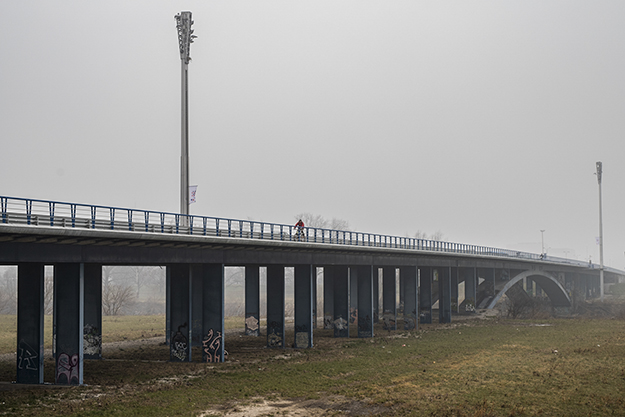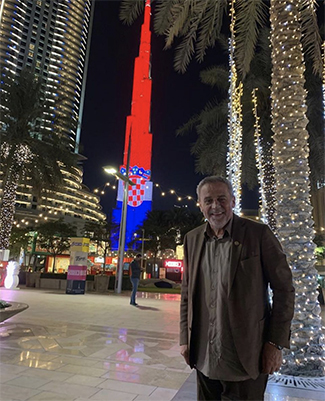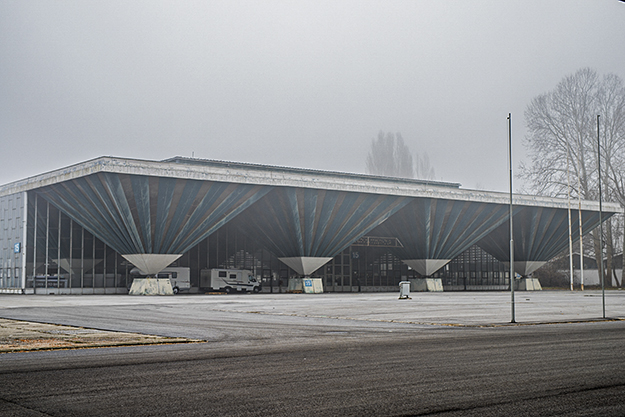Right next to the Sava River, which separates downtown from New Zagreb — an area dominated by residential buildings and skyscrapers — a promenade, luxury apartments and offices will be built.
“If somebody from Zagreb wants to build a 200-story skyscraper, let them build it — maybe someday I will have an office there,” the mayor Milan Bandić said at one point. He is also the brains behind the idea of the project many are calling “Zagreb’s Manhattan.”
Bandić, who has ruled over the Croatian capital since 2000, believes that Zagreb will enter the high society of western European capitals by making this project happen.
Opposing him are numerous civic initiatives, non-governmental organizations and experts. They all warn that this is a non-transparent and expensive project that will bring nothing to the inhabitants of the Croatian capital.
Unplanned development
In order to implement the “Zagreb’s Manhattan” project, the capital city would need to rezone 110 hectares of land by the Sava river, where the city’s Hippodrome and Velesajam (the city Fairgrounds) are currently located. The latter is a space of particular significance. The Velesajam has exceptional examples of architectural solutions for pavilions and “modern architecture” that are protected by the state’s Ministry of Culture.
Tihomir Jukić, professor at the Faculty of Architecture in Zagreb and president of the Croatian Chamber of Architects, within the Regional Committee of Zagreb, has been part of the community of experts that is preparing a project for the future development of the Velesajam for many years. He emphasizes that, while planning the design of the Velesajam’s space, they always thought of making it accessible for all citizens.
“The goal is to transform the urban and economic transformation of a neglected and closed complex into an ‘innovative urban area’ and open up this space with a new economic concept and new amenities. Making it attractive to both citizens and investors,” Jukić explains.

The area around the Velesajam in Zagreb could be turned into “Zagreb’s Manhattan” despite warnings from experts and urbanists. Photo: Sara Salamon.
More specifically, this would mean that the space would still be used for implementing contemporary fair-related activities but would also include hotels and a congress center.
Although there is also mention of convention halls and offices as part of the “Zagreb’s Manhattan” project, Jukić thinks that this doesn’t constitute a sustainable development opportunity for this space. According to him, the area including the Velesajam and the Hippodrome should be joined with Lake Bundek (a location across the street from the Hippodrome) and transformed into the “21st Century Park,” where all the necessary public infrastructure would be available.
“We could also learn something from Manhattan, but in a totally different way — not by building mega skyscrapers but by preserving the center’s green heart, Central Park,” Jukić adds, reminding us that there is only a small number of cities that can boast that their downtown center is a place of recreational, swimming and sunbathing activities in a natural idyll. All within an urban environment.
According to Iva Marčetić from the Pravo na Grad (Right to the City) association that advocates against privatization and excessive exploitation of public spaces, such unplanned city construction creates social enclaves enabling uneven development.
“There is no continuity in city development. The remaining city property is sold to the bidder the mayor finds most interesting,” Marčetić said. “This part of Zagreb is set apart as a separate entity that no longer belongs to us who live here and work in the city, because we won’t be the ones to buy luxurious apartments in “Zagreb’s Manhattan.”
She believes that the project is also problematic due to city traffic connections. In June 2019, a large hole appeared on the pedestrian part of the Sava Bridge. Only two years after the bridge’s renovation. Experts warned back then that Zagreb’s bridges are in extremely poor condition, and they should be closed down and renovated. The building of high skyscrapers and luxurious apartment buildings would put a new burden on that area.
“Our bridges are falling apart, Novi Zagreb doesn’t have a single hospital. If, say, there was an earthquake and something were to happen to the bridges, Novi Zagreb residents would be cut off from the city and its health services,” Marčetić warns, adding how the construction of “Manhattan” is set to continue no matter the dysfunctionality of these city planning aspects.
Lack of transparency
The “Zagreb’s Manhattan” project comes bundled with changes to the General Urban Plan (GUP), that is opposed by expert associations, because it would enable the construction of underground garages in the most highly valued locations downtown (meaning that motor traffic would intensify in the city center) and denser construction in the zone under the Sljeme mountain top.
According to architect Jukić, the main problem related to the “Zagreb’s Manhattan” project and the GUP changes comes down to non-transparency in implementing city projects.
“While proposing such a big project that is deemed of importance to the city, the Zagreb city administration should communicate with the public, and especially experts, in a completely different manner,” he believes.
The “Zagreb’s Manhattan” project and GUP changes have been introduced through the back door.
“It was only in June that we found out that the 2017 GUP change was completed, that a new text was prepared and that it will be voted upon in the City Assembly in July,” Marčetić explained.
“It was then that we realized that some significant changes were introduced for the area around Velesajam and Hippodrome, as well as a series of changes within GUP that were not discussed publicly, although this is required by law.”
Actually, the public only found out about the project when Milan Bandić boasted about signing a memorandum of understanding with the United Arab Emirates back in March 2019, in Dubai. He signed the memorandum with the Emirates’ businessman Mohamed Alabbar, who was in charge of the Eagle Hills company.
The same company is known in the Balkans for supporting the construction of the multi million dollar “Belgrade Waterfront” project in the capital city of Serbia.

The public learned about the project “Zagreb Manhattan” after Milan Bandić, mayor of Zagreb, visited Dubai in 2019. Photo: Milan Bandić Instagram profile.
From the very start, “Belgrade Waterfront” was advertised as a development project that would enable the capital city of Serbia to become the “Balkan Dubai.” It would also include a few buildings with luxury apartments, a shopping mall, parking area and a 150-meter high tower.
Twenty-thousand people were to be employed in its construction. As well as 3.2 billion dollars invested by Eagle Hills for the project. The Serbian government supported the project wholeheartedly, saying that its implementation is of national importance, enabling employment and GDP growth, as well as an increase in tourists.
However, numerous experts and civil sector activists have mobilized against it from the very beginning. They considered the project financially problematic and non-transparent.
“The ‘Belgrade Waterfront’ model was presented to the public, while the existing spatial planning framework was adapted to its design, ” Iva Čukić recalls. She is an architect in the Ministry for Space, an association dealing with issues related to city development, urban policies and transformation.
Public interest groups submitted initiatives and complaints due to the GUP changes. When the procedural solutions turned out to be a failure, large protests were organized under the slogan “Ne da(vi)mo Beograd” (Don’t Drown Belgrade). A giant yellow inflatable duckling became a symbol of resistance recognized throughout and outside of Serbia. Meanwhile protests in Belgrade gathered thousands of citizens.
Mass protests have come after the events that occurred on the night of April 25, 2016, when a group of some thirty armed and masked men used bulldozers to raze a number of buildings in Hercegovačka Street, a part of the Savamala neighborhood. They detained and immobilized passersby, taking away their mobile phones. The Belgrade police didn’t show up despite being called.
The perpetrators were never brought to justice.
Beyond expertise and the public’s eye
The “Belgrade Waterfront” has progressed quickly. Now there is a long promenade along the Sava river. Sunlight reflects off of the windows of luxury apartment buildings. However, it isn’t close to being finished. It is believed that a lot more money was spent than originally announced.
“A three-billion dollar investment was promised over a period of four years,” Iva Čukić explained, adding that the contract signed in 2015 says there will be a 30-year long construction period, including a loan to Serbia of around 300 million euro. However, the state is responsible for investing in infrastructure and terrain preparation.
At the beginning of 2019, the weekly magazine NIN tried to calculate the amount Serbia had spent on that project up until that point. It concluded that it amounted to 3.9 billion Serbian dinars, or almost 33 million euro for the land purchase and real estate necessary to implement the project. This is the amount spent only for 2018.
According to NIN’s article, published on the N1 portal, “the state is buying private companies with taxpayers money. Then ceding their real estate with no compensation in order to expand the Belgrade Waterfront project.”
“It should be noted that the Eagle Hills Company itself has used several large real estate properties, including, for example, the Geozavod building,” Čukić reminds us, adding that investing in infrastructure also includes the relocation of the railway and bus stations, and their re-construction in new locations. “This is all the construction that should be completed so that ‘Belgrade Waterfront’ can become functional,” she says.
It seems that the modus operandi of Bandić is similar: Pushing the project forward without the consent of professionals. Signing secret deals without revealing the true cost of the project and the terms of its implementation.
The contents of the memorandum signed by the mayor in Dubai was shrouded in secrecy. Finally, RTL television journalist Danka Derifaj obtained them after a few months of fighting with the city’s administration. The mayor’s office eventually relented under public pressure and the memorandum was released publically; up until that point, the memorandum was classified as a professional secret by the city authorities.
According to the memorandum, Bandić has committed to prepare all the documentation for the company within eight months. This would explain his hastiness with regards to speeding up the voting on GUP changes.
Non-governmental organizations believe this to be the reason why the mayor organized a public discussion over the summer, from August 1 to 14. This is when Zagreb is empty, as most people are on their vacations.
However, initiatives such as Pravo na Grad (Right to the City) or Zelena akcija (Green Action), as Marčetić recalls, prepared a set of complaints that were then shared among civil society activists and other initiatives. Architectural associations also followed by preparing their set of complaints.

The Velesajam in Zagreb is for many architects in Croatia a model of modern architecture. They warn of the damage a “Zagreb’s Manhattan” can cause. Photo: Sara Salamon.
“The city administration received 31,000 complaints. This is the largest number of complaints ever filed for a single General Urban Plan!” Marčetić says.
However, not a single complaint from the citizens was accepted. Only 17 complaints from the city services were adopted. “Also, complaints by professional associations were rejected. This shows once again that the public discussion was a farce,” she added.
Political transactions
Although, the structure of Zagreb’s local civil initiatives is pretty advanced at the neighborhood level and there are also central civil society organizations engaged in the struggle against this project; it is likely that the decision on its implementation will be made at the political level.
That Bandić has managed to stay in power for six terms despite the numerous affairs he was connected with (in October 2014, Bandić was arrested on charges of corruption and abuse of office, but he was released after paying bail), speaks volumes about his political savvy.
During the last elections, Bandić was still elected in the second round, albeit with a very small majority (51.79 percent of the vote). When he realized he needed a majority in the city assembly in 2017, he created a coalition with the Independence for Croatia party (Neovisni za Hrvatsku). This is a right-wing party centered around the candidates Bruna Esih and Zlatko Hasanbegović. Both of them have called for the removal of all symbols from the Yugoslav regime and for the lustration of all those who were active in high positions during that period in Croatia.
While they provided Bandić with the manpower he needed in the city assembly, he in turn allowed them to change the name of one of the central city squares from Marshal Tito to Republic Square in 2017.
In the meantime, this coalition has disintegrated but Bandić has managed to find new allies.
Bandić has only a relative majority in the City Assembly, and has only won one term during the parliamentary elections. Today he has a parliamentary club of around 15 MPs within the Croatian Parliament. It is precisely this club that the parliamentary majority of Andrej Plenković’s government (member of the ruling HDZ) is dependent on.
“His trade-off is clear: HDZ has to support Bandić in Zagreb in return for support of his fifteen MPs in the government that Bandić’s party isn’t officially a part of,” political analyst Davor Gjenero said. “The cost of the arrangement for HDZ is very high — under Bandić’s shadow, they can’t get their city organization up and running, they are constantly in a clientelistic based relationship toward him and the city authorities,” he concludes.
The seven members of the City Assembly from HDZ are helping Bandić form a majority. Whereas his 12 MPs are supporting HDZ to remain in power at the state level.
Since 2017, Bandić has experienced opposition from a younger group called “Zagreb is Ours” (Zagreb je naš) in the city assembly. In May 2017, only a few months after being established, they received almost eight percent of the vote.
Gjenero believes that, the longer Bandić stays in power the more difficult it will be to remove him. The political interests allowing him to be reelected are becoming more deeply rooted. While his decline or survival in power will depend first and foremost on the developments at the national level.
“Although Prime Minister Plenković is aware that Bandić is an expensive and uncomfortable partner who also strongly compromises him, there is no other way than to cooperate,” Gjenero says as part of his analysis, adding that the only alternative is to announce new elections.
“While the presidency of the European Union is ongoing, the prime minister can’t allow the risk of new elections,” he states.

The vote on the General Urbanization plan in Zagreb is set for February this year. That is when the final decision on “Zagreb’s Manhattan” will be made. Photo: Sara Salamon.
Croatia has taken over the six-month presidency of the EU at the beginning of 2020.
With these calculations in mind, HDZ’s local parliament members should support GUP. While Bandić’s MPs in the national parliament will vote for the budget at the state level.
At the end of November, Bandić took a step closer to implementing the project. The Ministry of Construction gave a positive opinion on changes to Zagreb’s GUP, envisioning the construction of “Zagreb’s Manhattan.”
“We have ensured full compliance with the law. But the city development and GUP isn’t decided on by the city’s policies but at the national level,” Predrag Štomar says. Štomar is the minister of construction, deputy prime minister and member of the Croatian People’s Party, that is part of the ruling coalition alongside HDZ.
“During the public discussion, thousands of complaints arrived, while it is up to the councilors in the assembly to decide whether to take them into consideration. Personally, I would never vote for a document where the content received so many objections from experts and the public,” Štromar told the Jutarnji list daily.
The next step is to vote on this document in the City Assembly, which is expected to happen in February at the earliest.
During the second round of presidential elections, on January 5, Zoran Milanović (left center opposition SDP party candidate) won in an upset. Bandić has now lost important support that was embodied by the former Croatian president Kolinda Grabar-Kitarović. She sang for him at a birthday party this year.
According to the analysis from the Croatian portal Telegram, her defeat could be explained by a large loss of votes in the city of Zagreb and Zagreb County. This may be attributed to the excessive closeness with the mayor. Whether this analysis proves to be correct or not, the election results will most definitely influence the position of Zagreb’s mayor on the Croatian political stage, as well as that of “Zagreb’s Manhattan.”K
Feature photo: Sara Salamon





